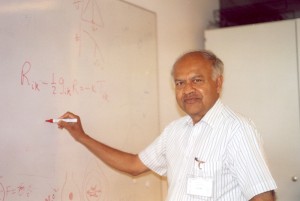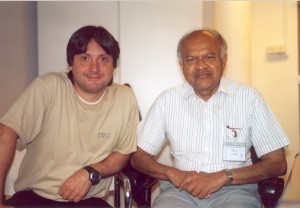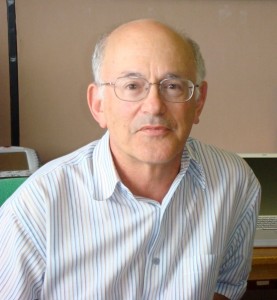Stars older than the universe. How can this possibly be?

A Sundial cast in stone
December 10, 2009
Stellar Death
December 22, 2009Wouldn’t it be nice for a scientist to be able to proof everybody else is wrong? And if you are in astrophysics, why shouldn’t you dream about showing that the cosmological castle is built on sand and you have found *the* thing that would make it fall apart? Don’t be shy, if you admit it, I would fully understand you 😉 The history of science is full of such examples, which have usually brought about far reaching revolutions, with effects that have gone well beyond the strict academic circles and, in the end, have influenced philosophy and the way we perceive the world. Just think about Copernicus… Many of us (including myself) spend their scientific careers working on subjects which are usually dubbed “small science”. Interesting and hard work, which though adds only small pebbles to the enormous wall of science. While there are others (among which cosmologists) who work on the “big science”, whose purpose is to investigate the grand picture of the universe. Certainly ambitious and not lacking fascination. In astrophysics it is quite common to have to deal with problems which involve most of known physics and (most intriguing) a good fraction of unknown physics. An example? Dark matter. We need it, but we do not have a clue about its nature. Another example? Inflation. Another, more recent example? Dark energy. And so on.
One of the reasons that pushed me into the arms of Science was the search for truth. This might sound more rhetoric than actually is. In school you are told that things are so and so. But at some point some of us develop an intimate need to verify this with their own eyes, hands and thoughts. And, in the most brilliant cases, one ends up giving her own view on things, finding a new law of nature, proving another one was wrong, inventing a new technique. Clearly, one can’t go out and try to verify each single bit of information she has been given. That would be mad. But it is the right (and the must) of any scientist to question certain things. Or, to put it in a more general way, to keep the doors open to other possibilities, although at the edge of the common understanding and the main stream.
As you may know, in the sixties the two models of the universe (Big Bang and Steady State) were equally valued and the debate was completely open. The Steady State Cosmology (SSC), the only serious alternative to Big Bang, had been proposed by Fred Hoyle, Thomas Gold and Herman Bondi, back in 1948. I will not enter here in the debate (which reached quite strong tones at some point) and I just mention that the SSC lost credit mostly with the discovery of the cosmic microwave background radiation in 1965. In the following decades the SSC almost disappeared from the scenes. However, in 1993, a modified version (the Quasi Steady State Cosmology, QSSC) was proposed by Fred Hoyle, Geoffrey Burbidge, and Jayant V. Narlikar. After this, Narlikar and his collaborators have worked quite a bit on it, especially after the new WMAP and Supernova data become available. The theory is still strongly adversed (and probably ignored) by the vast majority of cosmologists, who argue QSSC fails to reproduce the observed data (for instance, have a look at this note by E.L. Wright).
Although I have been interested in these issues, I certainly cannot claim I fully understand the arguments (on both sides). My field of research is rather far from theoretical cosmology and my expertise is more in observational astronomy. On top of that, I must admit I do not really care too much about cosmology in itself ;-). After all I am a stellar guy. However, a few years ago Jayant Narlikar visited ESO for six months. He gave a very interesting series of lectures (Cosmology from the Sidelines) and this has raised my curiosity. So, I proposed him to collaborate. The first thing that struck me was Jayant’s personality. He is a very reflective and calm person, armed with a disarming culture. Despite the fact that he grew up scientifically under the supervision of sir Fred Hoyle (one of the most brilliant astronomers of the 20th century), he his not an intimidating person. He has more than 200 publications in refereed journals, he has written several books (see for instance this one or this), and even science fiction. He is now the director of the Inter-University Centre for Astronomy and Astrophysics in Pune (India). I actually have a nice anecdote about him. While preparing the Shadow of the Earth, I was looking for an ancient poem somehow related to cosmology. And I really wanted to avoid the Genesis, because it has been used so many times in all possible ways. So, I wrote to Jayant asking for an advice. And he came up with a very interesting idea. “What you are looking for is the Hymn of Creation in the Rg’Veda” – he said. “You should find somebody that read Sanskrit on top of which another person would proclaim the translation“. This was happening only a week before the premiere. No time to organize such a thing (Sanskrit readers are not that common in this part of the world). So I wrote him back: “Jayant, why don’t you read it, record an mp3 and send it to me?“. A few days after I received the recording. Here you can listen to the original initial part (mp3), and here is the final version (synth: Glauco Venier; Voice: Massimo Somaglino). The result had a great effect.
At that time we were already working on a project, whose name was to search for stars older than the Universe. The sentence sounds awkward. And it is awkward, indeed. According to the so called concordance model (which tries to put everything together) our universe is about 13.7 billion years old. Therefore, all objects in this universe must be younger than this figure. Quoting Jayant: “The daughter cannot be older than her mother”. From this comes the basic idea: if you find objects with an age larger than, say, 15 billion years, then the standard model is in trouble. Of course things are not as easy as they seem. At the beginning Jayant thought about dating white dwarfs. These old objects set on a cooling track and, using theory and observed data one can in principle date them. But at the age of, say, 20 billion years, they are damn faint. At some point Jayant brought up the issue with Ken Freeman, a well known astronomer now professor at the Research School of Astronomy & Astrophysics, Mount Stromlo Observatory (Australia). And finally Ken came up with an interesting proposal. I will not go into the details here, but the concept is that if stars older than 15 billion years do exist, they should show up when one looks sufficiently deep in a particular region of the Hertzsprung-Russel diagram of a stellar population. This practically means taking very deep, multi color images of stellar fields at a known distance (so that at least one unknown is… well… known). After long discussions we have decided to go for the Large Magellanic Cloud, the well studied galaxy, satellite to our Milky Way. A major role in this project has been played by Vijay Mohan, post-doc at the Inter-University Centre for Astronomy and Astrophysics under the supervision of Jayant. He is the one who has done the real work, reducing and analyzing the data (taken both with the Very Large Telescope and the Hubble Space Telescope).
Do not think this is an easy task. It is difficult for two reasons: 1) you are going against the main stream, so that prejudice plays an important part in the game; 2) you are questioning the very fundaments of a well established theory. Therefore you have to provide solid arguments for your conclusions. Extraordinary claims require extraordinary evidence, used to say Carl Sagan. Even within the collaboration long discussions took and still are taking place. But almost after two years, last week, I received a draft of the paper, whose title is ” Observational evidence for old stars“. The claim is rather strong, although in the paper a number of possible alternative explanatiosn to what we have found are duly discussed. The manuscript will have now to go through the refereeing process, which I can anticipate will be quite painful.
I do not really known which cosmological model is the right one. I would not stick my [small] reputation to the claim that we have found 20 billion years old stars. But certainly, this has been a very interesting and stimulating experience, and has exposed me to two very brilliant and open minds, those of Ken and Jayant. Thankyou lads for sharing this with me!





9 Comments
I am wondering whether you guys included the fact that universe is expanding. My guess would be If your calculations are based on linear scale( not accelerating) then you may see 20 billion years old stars which are not actually
You mention in the article that the CBR supports the Big Bang Theory. I think the CBR actually supports a Steady State Universe even more. The fact that the universe is flat also supports a SSU. The reason the CBR supports a SSU is because it is nearly uniform in every direction when viewed from the earth. This is highly unlikely in a BB universe unless we just happen to be in the center of the BB universe. No scientist wants to claim that again so they proposed the inflationary period to get around this little problem.
The red-shift may be just an illusion as proposed in a third theory of light, it would increase in intensity as it is red-shifted downward in frequency. This increase in intensity is required to conserve the light’s energy and momentum. This is all explained in the Waves of Particles Theory of Light published online for all to read.
http://www.scribd.com/doc/16251160/An-Alternative-to-the-Standard-Model-of-Physics
Nice posting. Do you know about these Sanskrit books?
http://www.YogaVidya.com/freepdfs.html
Thanks for the comments.
In general my posts do not receive any. But I was sure this one would do. For some reason cosmology is always matter of interest. Or better, it is the debate in cosmology that arises interest in the public.
Here follow the answers:
1) The Large Magellanic Cloud is next door. The effects of universal expansion are negligible. One of the basic concepts of our method is to stay away from any cosmological assumption. Our estimates purely rely on stellar evolution theory.
2) The CMBR was used by the BB supporters as a strong argument against SSC. This is a fact. That CMBR does or does not rule out SSC or QSSC is a different story. As I said, this is not my field and I leave to cosmologists and future data to clarify the issue. Q/SSC makes strong predictions, and sooner or later it will be easy to see who was right ;-). I just add here that other scenarios do exist. The Plasma-Theory is one of them . See http://www.plasmaphysics.org.uk/research/redshift.htm
3) No, I am not an expert on Sanskrit books (but Jayant is. His mother was a scholar in Sanskrit). What I have done is a translation into Italian of the Hymn of Creation. But that was from the English version.
It is more important to focus on spiritual sciences than physical ones. Physics can give you knowledge only about physical things in the world. Spiritual sciences can make you realize the ultimate aim in life. Isn’t it?
Webmaster-Translations:
http://freetranslationblog.blogspot.com
There is not such a thing as “spiritual science”. Unless one can define in scientific terms what the spirit is.
I have a blog against the expansion of the universe, with arguments that show this is impossible.
How the people consider there are evidences for the Big Bang I study these evidences.
I have arguments and Hypotheses in: http://bigbangno.wordpress.com
Thanks.
I’m kind of wondering why older stars could not be found. If the present cosmology is wrong it would seem that stars older than 20 billion years would be out there. I guess white dwarfs are very difficult to age date and small stars that could be that age are very difficult to see. It would seem that if such stars existed then they seemingly would have already been discovered.
Although I have seen a few such claims over the many years they are very rare. If such aged stars exist it would seem that either its very hard to determine their ages, or few wish to publish findings contrary to the mainstream model.
i’m an iranian student. i strongly believe there’s no bigbang and it’s just big lie.
i’m one those people that will loudly cry “no big bang” with the results of your research.
wish you success